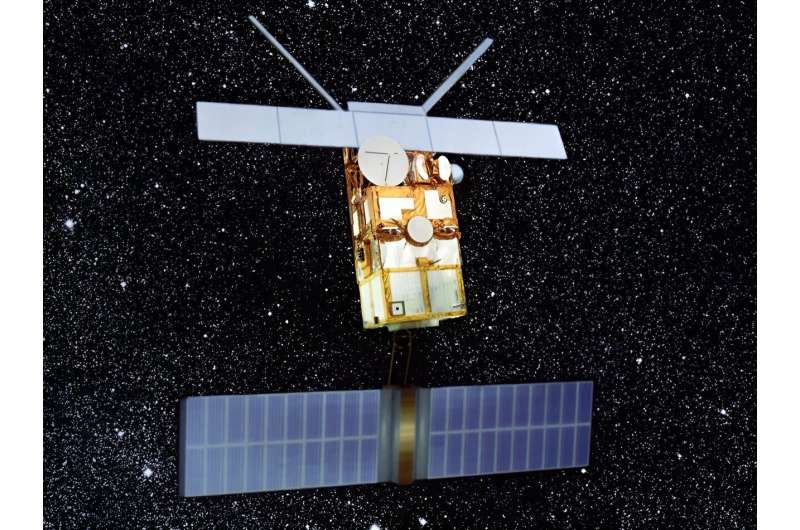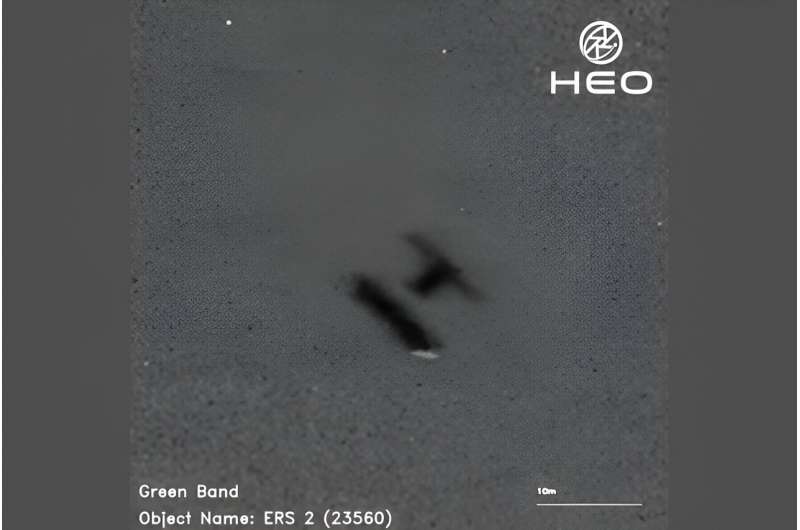This article has been reviewed according to Science X's editorial process and policies. Editors have highlighted the following attributes while ensuring the content's credibility:
fact-checked
trusted source
proofread
Heritage ERS-2 satellite returns to Earth

Launched in 1995, ERS-2 was a pioneering Earth observation satellite that greatly influenced our understanding of our planet and climate change. Despite an intended operational life of only three years, the satellite had a 16-year operational lifetime, and together with the almost identical ERS-1 satellite left an important legacy for the future of Earth observation.
ERS-2 collected a wealth of valuable data about our planet's land surfaces, oceans and polar caps, and also monitored natural disasters including severe flooding and earthquakes in remote parts of the world.
Although the satellite was still functioning, the European Space Agency (ESA) brought the mission to an end in 2011. The longer an inactive satellite remains in orbit, the greater the risk of collision with other satellites or space debris, so the decision was made to lower the ERS-2's average altitude from 785km above the Earth to 573km, thus commencing the de-orbit process. This reduced the time that that the spacecraft would spend in orbit from more than 100 years to less than 15.

At the time of launch, the ERS-1 and ERS-2 satellites were the most sophisticated Earth observation satellites ever developed in Europe. In March 2000, a computer failure led to the end of the ERS-1 mission, however ERS-2 would survive for much longer.
Surface temperature data is needed for weather forecasting, ocean prediction and climate monitoring, and while "in situ" measurements (e.g., from buoys) are useful, satellite data can cover the whole ocean, including in remote regions. Both ERS-1 and ERS-2 carried an instrument called the Along Track Scanning Radiometer (ATSR), which enabled scientists to accurately estimate temperature by detecting infrared heat from the Earth's surface.
The ATSR series were originally developed by a U.K. consortium led by RAL Space, and have gone on to influence future instruments including the Sea and Land Surface Temperature Radiometer (SLSTR) for ESA's Sentinel-3 satellites. The series are considered among the most accurate remote sensing instruments in terms of data calibration, having provided a "gold standard" for Earth's surface temperatures over a period of more than 20 years.
The heritage of ATSR and its successors means that many staff have fond memories of the series—these include our former director Professor Chris Mutlow, who reflects on the ERS-1 launch as one of his most memorable RAL Space moments in this article from 2022.
Group leader Dave Smith says, "ERS-2 was the very first mission that I worked on," says Dave, "so it's sad in a way to hear that the end has finally come. However the mission leaves behind an impressive legacy that lives on through numerous other past, present and future Earth observation satellites. It's a bittersweet moment for the community but we should be really proud of the mission's success."
ERS-2 also carried the Global Ozone Monitoring Experiment (GOME), which was the first ESA instrument to observe atmospheric trace gases in space. RAL Space's remote sensing group were involved in analyzing the data from GOME, which led to the first direct measurements of tropospheric ozone from space, and also contribute to long term records of ozone profiles from GOME and its successor instruments.
GOME and its successors continue to feed data into the European Union's Copernicus Climate Change Service, which provides consistent and reliable information to inform EU policies around climate change.
Provided by RAL Space





















